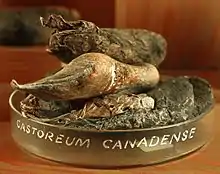Castoreum
Castoreum /kæsˈtɔːriəm/ is a yellowish exudate from the castor sacs of mature beavers. Beavers use castoreum in combination with urine to scent mark their territory.[1][2] Both beaver sexes have a pair of castor sacs and a pair of anal glands, located in two cavities under the skin between the pelvis and the base of the tail.[3] The castor sacs are not true glands (endocrine or exocrine) on a cellular level, hence references to these structures as preputial glands, castor glands, or scent glands are misnomers.[4]

It is used as a tincture in some perfumes[5] and, rarely, as a food additive.[6]
Chemical composition
At least 24 compounds are known constituents of beaver castoreum. Several of these have pheromonal activity, of which the phenols 4-ethylphenol and catechol and the ketones acetophenone and 3-hydroxyacetophenone are strongest. Five additional compounds elicit a weaker response: 4-methylcatechol, 4-methoxyacetophenone, 5-methoxysalicylic acid, salicylaldehyde, and 3-hydroxybenzoic acid.[7] There are also oxygen-containing monoterpenes such as 6-methyl-l-heptanol, 4,6-dimethyl-l-heptanol, isopinocamphone, pinocamphone, and two linalool oxides and their acetates.[8] Other compounds are: benzoic acid, benzyl alcohol, borneol, o-cresol, 4-(4'-hydroxyphenyl)-2-butanone, hydroquinone, phenol. All those compounds are gathered from plant food.[9] It also contains nupharamine alkaloids[10] and castoramine,[11] and cis-cyclohexane-1,2-diol.[12]
Uses
In perfume

In perfumery, the term castoreum refers to the resinoid extract resulting from the dried and alcohol tinctured beaver castor.[13] The dried beaver castor sacs are generally aged for two or more years to mellow.
Castoreum is largely used for its note suggesting leather, typically compounded with other ingredients including top, middle, and base notes. Some classic perfumes incorporating castor are Emeraude, Chanel Antaeus, Cuir de Russie, Magie Noire, Lancôme Caractère, Hechter Madame, Givenchy III, Shalimar, and many "leather" themed compositions.[5]
In food
In the United States, the Food and Drug Administration lists castoreum extract as a generally recognized as safe (GRAS) food additive.[14] In 1965, the Flavor and Extract Manufacturers Association's GRAS program (FEMA 2261 and 2262) added castoreum extract and castoreum liquid.[15] The annual industry consumption is very low, around 100 kilograms (300 lb),[16] whereas vanillin is over 1.2×106 kg (2.6×106 lb) annually.[17]
Castoreum has been traditionally used in Sweden for flavoring a variety of schnapps commonly referred to as Bäverhojt (lit. 'beaver shout').[18][19]
Other
Castoreum was also considered for use to contribute to the flavor and odor of cigarettes.[20]
Medieval beekeepers used castoreum to increase honey production.[9]
Related animal products
- Taxea, a secretion of the badger's subcaudal glands comparable in its medicinal use to the better-known castoreum
- Hyraceum, the petrified and rock-like excrement composed of urine and feces excreted by the Cape hyrax (Procavia capensis), and a sought-after material that has been used in traditional South African medicine and perfumery
References
- Walro, J.M. and Svendsen, G.E., "Castor sacs and anal glands of the North American beaver (Castor canadensis): their histology, development, and relationship to scent communication". Journal of Chemical Ecology, Volume 8, Number 5 / May 1982, Department of Zoology and Microbiology, Ohio University,
- Müller-Schwarze, Dietland (1992). "Castoreum of beaver (Castor canadensis): function, chemistry and biological activity of its components". Chemical Signals in Vertebrates IV, 457–464, Plenum Press.
- Johnston, Robert E.; Sorenson, Peter W.; and Müller-Schwarze, Dietland (1999). Advances in Chemical Signals in Vertebrates, Springer, 1, 282. ISBN 0-306-46114-5.
- Svendsen, G.E., Huntsman, W.D, "A field Assay of Beaver Castoreum and Some of its Components". American Midland Naturalist, Vol. 120, No. 1 (Jul. 1988), pp. 144–149, University of Notre Dame. JSTOR 2425894.
- International Perfume Museum, Grasse, France, Website: "Welcome in the International Perfume Museum: Raw materials". Archived from the original on 2007-06-24. Retrieved 2006-02-28.
- Burdock, G. A. (2007-01-01). "Safety assessment of castoreum extract as a food ingredient". International Journal of Toxicology. 26 (1): 51–55. doi:10.1080/10915810601120145. ISSN 1091-5818. PMID 17365147. S2CID 39977652.

- Pheromonal activity of single castoreum constituents in beaver, Castor canadensis., Müller-Schwarze, D and Houlihan, P.W., Journal of Chemical Ecology, April 1991, Volume 17, Number 4, Springer Netherlands, doi:10.1007/BF00994195
- Neutral compounds from male castoreum of North American beaver, Castor canadensis. Rong Tang, Francis X. Webster, Dietland Müller-Schwarze, Journal of Chemical Ecology, November 1995, Volume 21, Issue 11, pages 1745–1762, doi:10.1007/BF02033674
- The Beaver: Its Life and Impact. Dietland Muller-Schwarze, 2003, page 43 (book at Google Books)
- Stereoselective synthesis of enantiomerically pure nupharamine alkaloids from castoreum. Stoye A, Quandt G, Brunnhöfer B, Kapatsina E, Baron J, Fischer A, Weymann M and Kunz H, Angew Chem Int Ed Engl., 2009, volume 48, issue 12, pages 2228–2230, doi:10.1002/anie.200805606
- Zur Kenntnis der stickstoffhaltigen Inhaltsstoffe von Castoreum. B. Maurer and G. Ohloff, Helvetica Chimica Acta, 2 June 1976, Volume 59, Issue 4, pages 1169–1185, doi:10.1002/hlca.19760590420
- cis-Cyclohexane-1,2-diol in the beaver gland. Z. Valenta, A. Khaleque, M. H. Rashid, Experientia, 1961, Volume 17, Issue 3, page 130, doi:10.1007/BF02160827
- Hyraceum.com, "Castoreum, Perfumer's Ancient Intrigue," http://www.hyraceum.com Archived February 7, 2013, at the Wayback Machine
- Burdock GA (2007). "Safety assessment of castoreum extract as a food ingredient". International Journal of Toxicology. 26 (1): 51–5. doi:10.1080/10915810601120145. PMID 17365147. S2CID 39977652.

- Recent Progress In the Consideration Under of Flavoring Ingredients the Food Additives Amendment (1965)
- Burdock, George A., Fenaroli's handbook of flavor ingredients Archived 2021-01-09 at the Wayback Machine. CRC Press, 2010. p. 273-5.
- Burdock, George A., Fenaroli's handbook of flavor ingredients Archived 2021-01-09 at the Wayback Machine. CRC Press, 2010. p. 674.
- Baron Ambrosia (26 February 2015). "Tales from the Fringe: Beaver Gland Vodka". PunchDrink.com. Retrieved 11 December 2015.
- "BVR HJT". Archived from the original on 2013-08-26. Retrieved 2013-09-16.
- United States Patent Application Publication